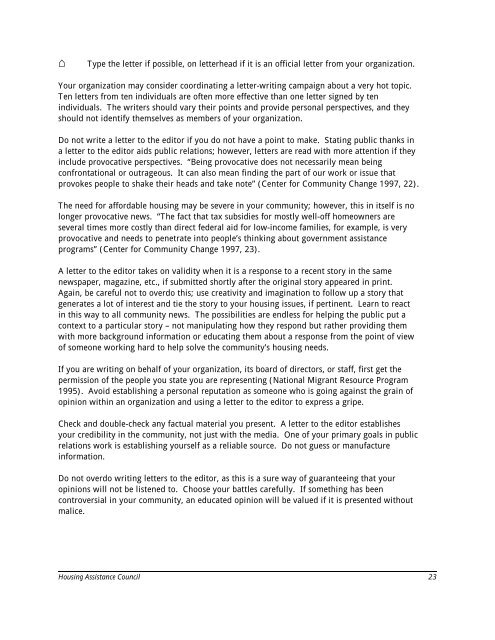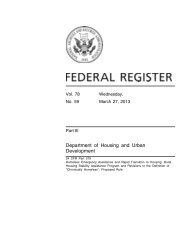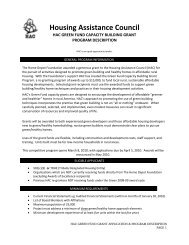Public Relations Guide for Rural Housing Organizations (manual
Public Relations Guide for Rural Housing Organizations (manual
Public Relations Guide for Rural Housing Organizations (manual
You also want an ePaper? Increase the reach of your titles
YUMPU automatically turns print PDFs into web optimized ePapers that Google loves.
- Type the letter if possible, on letterhead if it is an official letter from your organization.Your organization may consider coordinating a letter-writing campaign about a very hot topic.Ten letters from ten individuals are often more effective than one letter signed by tenindividuals. The writers should vary their points and provide personal perspectives, and theyshould not identify themselves as members of your organization.Do not write a letter to the editor if you do not have a point to make. Stating public thanks ina letter to the editor aids public relations; however, letters are read with more attention if theyinclude provocative perspectives. “Being provocative does not necessarily mean beingconfrontational or outrageous. It can also mean finding the part of our work or issue thatprovokes people to shake their heads and take note” (Center <strong>for</strong> Community Change 1997, 22).The need <strong>for</strong> af<strong>for</strong>dable housing may be severe in your community; however, this in itself is nolonger provocative news. “The fact that tax subsidies <strong>for</strong> mostly well-off homeowners areseveral times more costly than direct federal aid <strong>for</strong> low-income families, <strong>for</strong> example, is veryprovocative and needs to penetrate into people’s thinking about government assistanceprograms” (Center <strong>for</strong> Community Change 1997, 23).A letter to the editor takes on validity when it is a response to a recent story in the samenewspaper, magazine, etc., if submitted shortly after the original story appeared in print.Again, be careful not to overdo this; use creativity and imagination to follow up a story thatgenerates a lot of interest and tie the story to your housing issues, if pertinent. Learn to reactin this way to all community news. The possibilities are endless <strong>for</strong> helping the public put acontext to a particular story – not manipulating how they respond but rather providing themwith more background in<strong>for</strong>mation or educating them about a response from the point of viewof someone working hard to help solve the community’s housing needs.If you are writing on behalf of your organization, its board of directors, or staff, first get thepermission of the people you state you are representing (National Migrant Resource Program1995). Avoid establishing a personal reputation as someone who is going against the grain ofopinion within an organization and using a letter to the editor to express a gripe.Check and double-check any factual material you present. A letter to the editor establishesyour credibility in the community, not just with the media. One of your primary goals in publicrelations work is establishing yourself as a reliable source. Do not guess or manufacturein<strong>for</strong>mation.Do not overdo writing letters to the editor, as this is a sure way of guaranteeing that youropinions will not be listened to. Choose your battles carefully. If something has beencontroversial in your community, an educated opinion will be valued if it is presented withoutmalice.<strong>Housing</strong> Assistance Council 23









